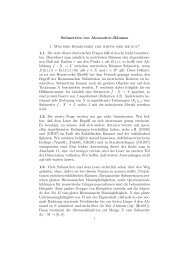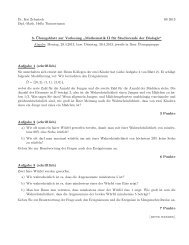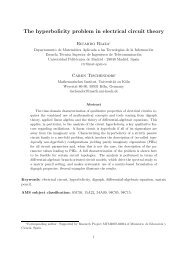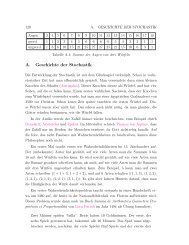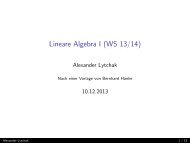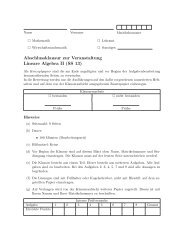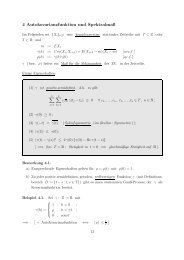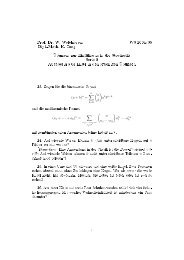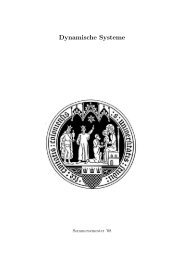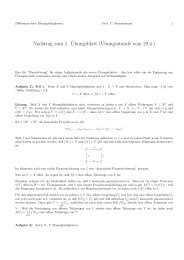Inhaltsverzeichnis - Mathematisches Institut der Universität zu Köln
Inhaltsverzeichnis - Mathematisches Institut der Universität zu Köln
Inhaltsverzeichnis - Mathematisches Institut der Universität zu Köln
You also want an ePaper? Increase the reach of your titles
YUMPU automatically turns print PDFs into web optimized ePapers that Google loves.
DMV Tagung 2011 - <strong>Köln</strong>, 19. - 22. September<br />
Herbert Spohn<br />
Zentrum für Mathematik, Technische <strong>Universität</strong> München<br />
The one-dimensional KPZ equation and its universality class<br />
In 1986 Kardar, Parisi, and Zhang proposed a stochastic PDE for the motion of driven interfaces. Bertini<br />
and Giacomin (1997) explained how to approximate the solution to the 1D KPZ equation through the<br />
weakly asymmetric simple exclusion process. Based on work of Tracy and Widom on the PASEP, we<br />
report a formula for the one-point generating function of the KPZ equation in the case of sharp wedge<br />
initial data. The long time limit is given by the Tracy-Widom distribution from GUE random matrices. Of<br />
particular interest are the finite time corrections. This is joint work with Tomohiro Sasamoto.<br />
Rainer Verch<br />
<strong>Universität</strong> Leipzig<br />
Quantum fields on non-commutative space: non-commutative potential scattering and Wick<br />
rotation<br />
In this talk, two different strands of quantum field theory on non-commutative space will be presented.<br />
First, the scattering of the quantized Dirac field on Minkowski spacetime will be discussed, and it will be<br />
explained how this gives rise to observables of the quantized Dirac field on Moyal-deformed Minkowski<br />
spacetime. Furthermore, it will be argued that this construction is a model for obtaining a correspondence<br />
between more general Lorentzian non-commutative geometries in the sense of spectral geometry and<br />
observables of quantum field theories over such non-commutative Lorentzian geometries. In the second<br />
strand of the talk, the problem of Wick rotation, i.e. the relation between a quantum field theory on<br />
Euclidean space on one hand, and Minkowski spacetime on the other, will be generalized for the Moyal<br />
deformations of Euclidean space and Minkowski spacetime. It will be shown that there is a relation if the<br />
Moyal deformation leaves the time coordinate untouched. These latter results were obtained in joint work<br />
with H. Grosse, G. Lechner and T. Ludwig.<br />
Stefan Weinzierl<br />
<strong>Universität</strong> Mainz<br />
Hidden mathematical beauty in scattering amplitudes<br />
This talk will be on a topic related to mathematics and (particle) physics. Scattering amplitudes in<br />
particle physics are related to the probability with which a certain scattering process occurs. The<br />
scattering amplitudes are calculable in perturbation theory. Higher or<strong>der</strong>s in the perturbative expansion<br />
are needed for precision predictions for the experiments at the LHC colli<strong>der</strong>. Recent progress in the<br />
calculation of scattering amplitudes has shown that these scattering amplitudes have a much simpler<br />
structure than previously believed. This simplicity is directly related to mathematical structures hiding<br />
un<strong>der</strong>neath. The complexity of scattering amplitudes increases with the number of external legs and<br />
with the number of internal loops. Simplicity with respect to the number of external legs is obtained<br />
by formulating the theory not in space-time, but in twistor space instead. Simplicity with respect to<br />
the number of internal loops is obtained by making use of the algebra of transcendental functions, like<br />
the algebra of multiple poly-logarithms. Here, particle physics touches the domain of the theory of motives.<br />
76




